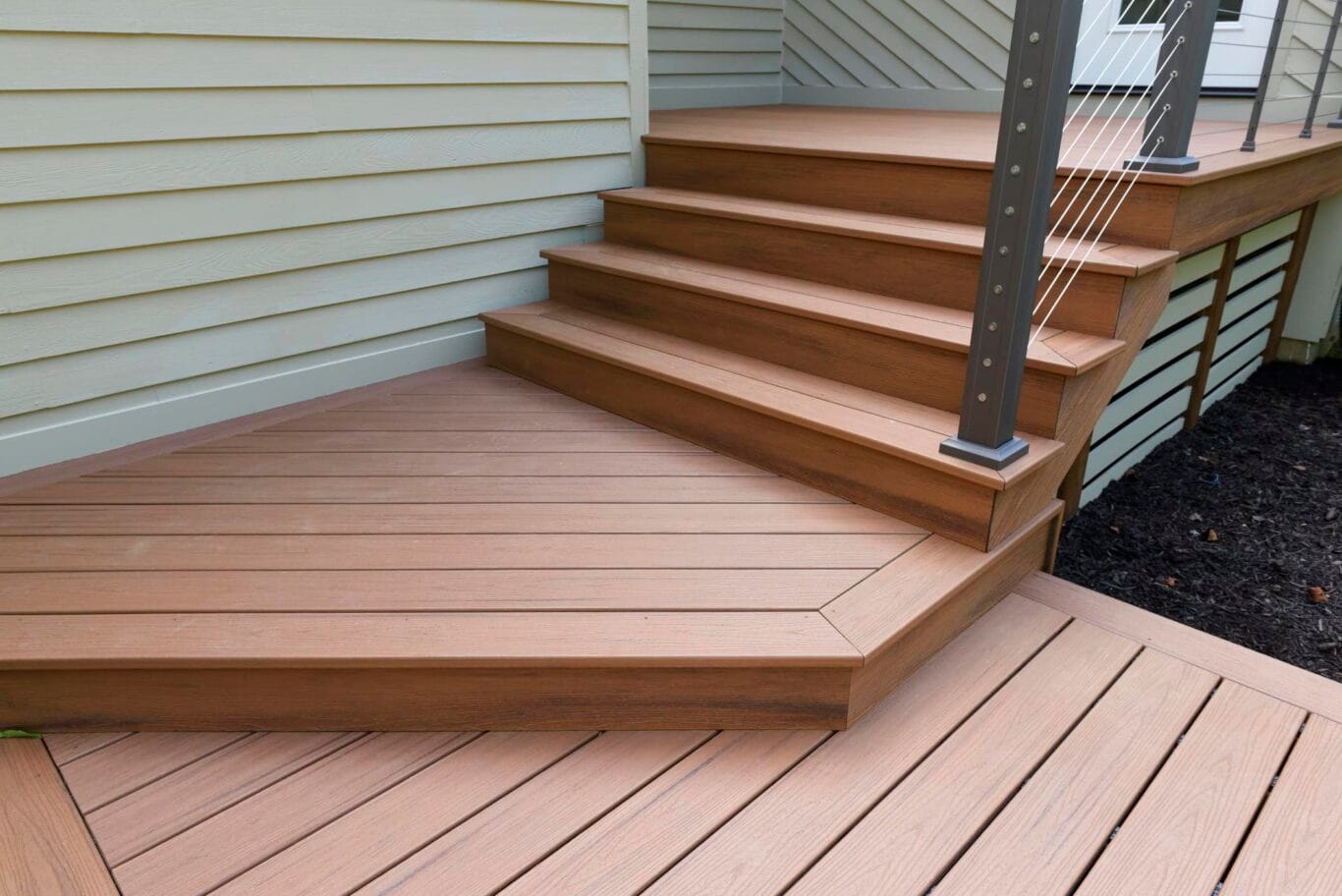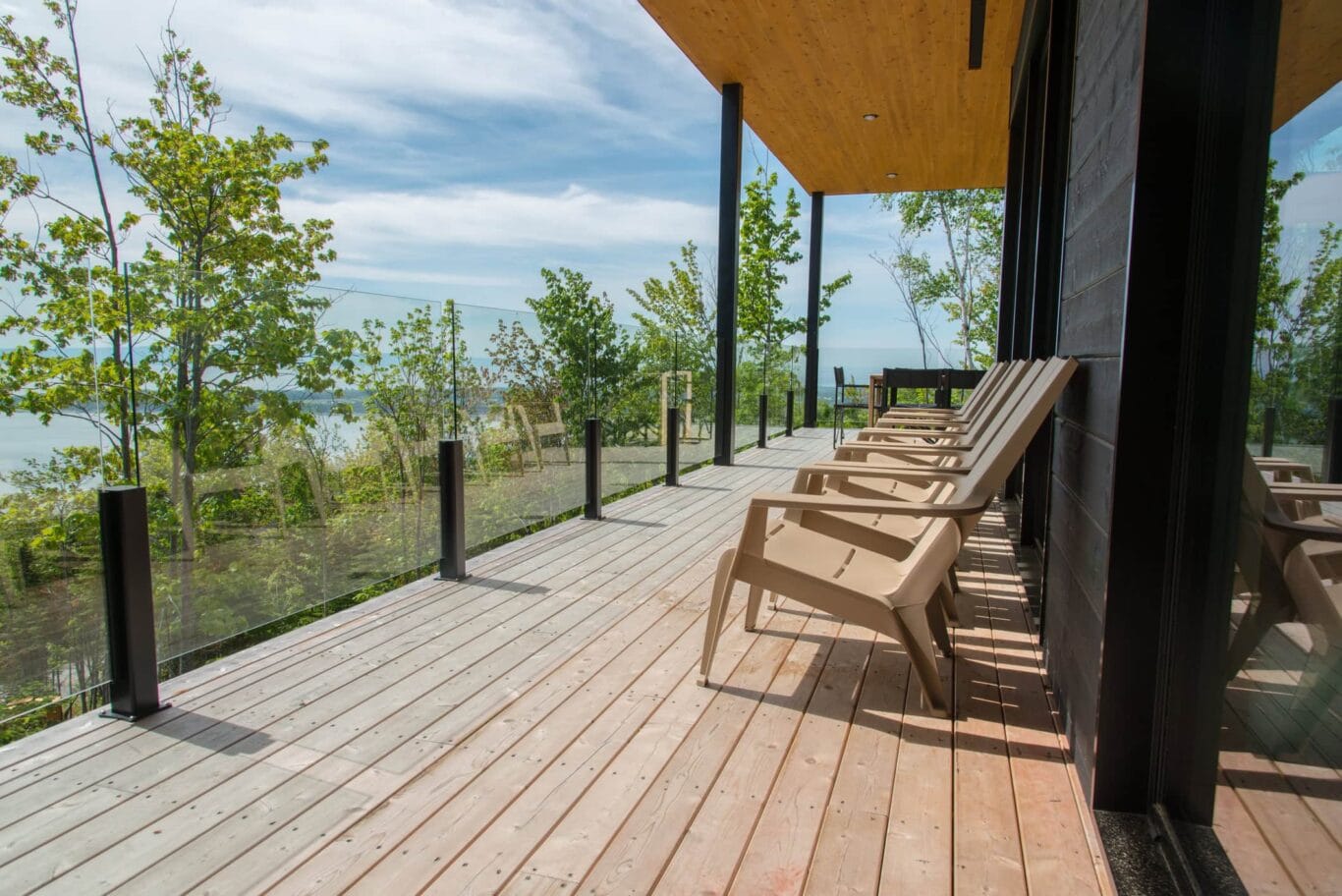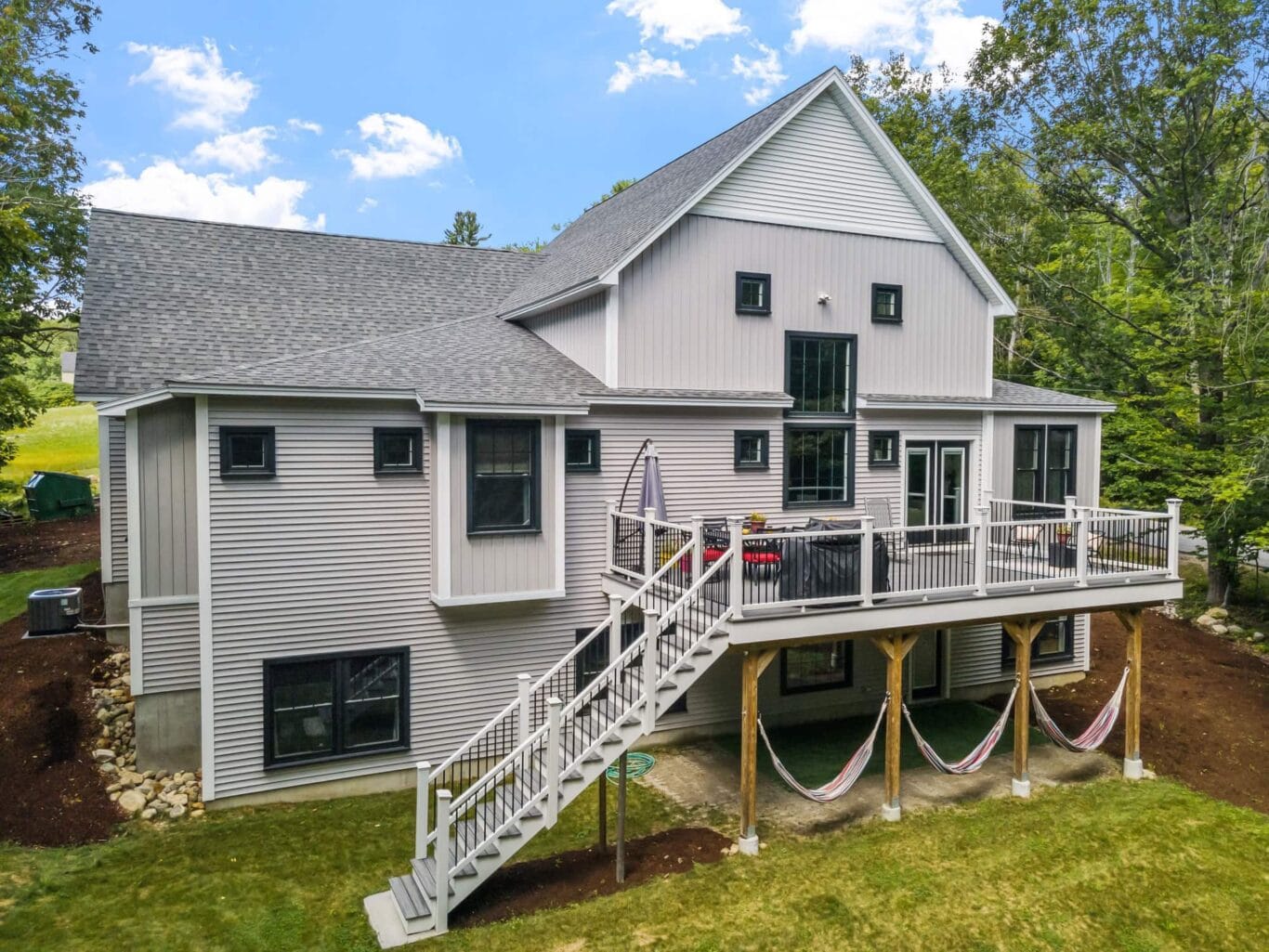Table of Contents
Deck stairs and railings are more than just structural elements—they’re essential for any outdoor space’s safety, aesthetics, and functionality. Whether aiming to enhance your deck’s curb appeal, meet safety regulations, or boost convenience, choosing the right deck stairs and railings can make all the difference. From sleek aluminum railings to classic wood deck railings and innovative hidden fasteners, there are countless options to suit your style and budget.
In this guide, we’ll explore everything you need to know about deck stairs and railings—from selecting the best materials and fasteners to understanding code requirements and lighting choices. Whether designing a new deck or upgrading an existing one, this comprehensive guide will help you create a durable and inviting outdoor space. Let’s explore the essentials and find the ideal blend of safety, style, and accessories for your deck!
How To Choose a Railing?
Choosing the right railing for your deck is an essential part of crafting an outdoor space that blends safety, style, and comfort. Whether you’re planning a cozy retreat or a sleek modern deck, the railing you choose plays a big role in both the functionality and overall aesthetic. The key is to strike a balance between appearance, long-term durability, and safety—all while ensuring compliance with local building codes.
Fortunately, today’s deck railing options are more diverse than ever. They range from classic wood railings that bring warmth and charm, to low-maintenance composite railings designed for easy living, and even aluminum or glass railings for a modern, minimalist vibe. With so many deck railing materials available, you can find the perfect fit to complement your design goals and lifestyle needs.
Since each type of railing has pros and cons—like maintenance requirements, cost, and longevity—it’s worth exploring each in detail before making a final decision. Later in the article, we’ll take an in-depth look at these materials to help you choose a solution that offers the perfect combination of style, durability, and ease of upkeep.
Safety Tip: Adhering To Railing Height Codes
No matter which material you choose, it’s essential to comply with the codes for the height of the deck railing so that your deck is safe, accident-free, and inspection-ready. In most regions, the required railing height for residential decks is 36 to 42 inches, measured from the deck surface to the top of the railing. Since regulations may vary by region, it’s always best to consult your local building authority for specific requirements.
By carefully weighing the pros and cons of each deck railing material and ensuring compliance with local regulations, you can create a safe, stylish, and durable outdoor space that enhances your deck’s functionality and visual appeal.
What Is Best for Outdoor Stairs?
The right choice of materials for deck stairs is vital to ensure durability, safety, and a cohesive look for your outdoor space. With several options available for deck stairs and railings, picking materials that align with your maintenance preferences and design goals is essential.
Here are some common materials:
- Wood Deck Stairs: These are classic and versatile, offering natural beauty that complements various deck designs. However, wood stairs require regular sealing and staining to prevent moisture damage and prolong lifespan.
- Composite Deck Stairs: Composite materials are popular for their low-maintenance appeal and high durability. They resist rot, insects, and weathering, making them excellent for the long term.

- Concrete Deck Stairs: For ground-level decks or patios, concrete stairs provide unmatched durability and weather resistance. They require little maintenance and can be customized with different textures or finishes.
By carefully selecting the right materials and installation methods, you can build deck stairs that are both functional and visually appealing.
What Is Outdoor Area Lighting?
Outdoor lighting goes beyond mere practicality—it enhances the safety and aesthetics of your deck. The proper lighting can transform your deck or patio into a cozy, inviting space to relax under the stars or host evening gatherings. Strategically placed outdoor lights improve visibility on deck stairs and railings, reducing the risk of tripping while adding a refined, elegant touch to your design.
Well-chosen lighting can elevate your deck’s appeal by highlighting architectural features or creating a warm ambiance. From enhancing safety to setting the perfect mood, outdoor lights play a vital role in making your outdoor space functional and beautiful.
What Light Is Best for Outdoor Lights?
When selecting the best outdoor lights, consider durability, energy efficiency, and style. Here are some popular lighting options:
- Recessed Lights: These are installed directly into deck stairs or the deck floor, providing subtle, focused illumination. Recessed lights are ideal for enhancing visibility on steps and walkways, reducing the risk of tripping.
- String Lights: String lights are perfect for creating a cozy, festive atmosphere. They’re easy to install along railings or overhead structures and add a warm, decorative glow to your deck.
- Post Cap Lights: Mounted on top of deck railings, post cap lights provide consistent, even lighting around the perimeter of your deck. They’re both functional and stylish, adding a touch of flair to your deck while keeping things safe and secure.
When considering what is best for outdoor lighting, prioritize weather-resistant lights designed to withstand rain, wind, and extreme temperatures. LED lights are often the best choice due to their energy efficiency, long lifespan, and brightness levels. Additionally, solar-powered lights can be an eco-friendly alternative, reducing energy costs while offering convenience.
By strategically placing outdoor lights along deck stairs and railings and around seating areas, you’ll improve safety and add ambiance to your outdoor space, making it enjoyable day or night.
What Is the Best Deck Railing Material?
Choosing the best deck railing material is critical in enhancing your deck’s safety, style, and durability. With various deck railing materials available, balancing your design preferences with factors like maintenance and budget is key. Below is a closer look at some popular railing options:
- Wood Deck Railings: Classic and versatile wood deck railings remain popular due to their natural beauty and customizability. They can be stained or painted to match your deck’s aesthetic. However, wood requires regular upkeep, such as staining and sealing, to protect against weather, rot, and insect damage.
- Aluminum Railing: Are aluminum railings good? Absolutely! Aluminum railings are praised for their sleek appearance, rust resistance, and minimal maintenance. Unlike wood, aluminum doesn’t require regular sealing or painting, making it ideal for homeowners seeking a long-lasting, hassle-free solution. Additionally, aluminum is lightweight and easy to install, which helps reduce labour costs.
- Composite Deck Railings: Composite deck railings are an excellent option for durability and low maintenance. Made from wood fibres and plastic, they are very resistant, making them perfect for areas with extreme weather conditions. While composite railings may have a higher upfront cost, they offer long-term savings due to their minimal maintenance needs.
- Deck Glass Railing: If you’re aiming for a modern, unobstructed view of your surroundings, a deck glass railing might be your top choice. Glass railings provide a sleek, contemporary look and allow for greater visibility, making them ideal for decks with scenic views. But are there any safety concerns with glass railings? Yes, there are a few. While most deck glass railings are made from tempered safety glass, there’s still a slight risk of breakage or cracking. Regular cleaning is also necessary to maintain their clarity and aesthetic appeal.

Final Thoughts on Railing Materials
Here’s a quick comparison of popular deck railing materials, highlighting their key advantages and potential drawbacks to help you make an informed decision:
| Railing Material | Pros | Cons |
| Wood | Affordable, customizable, natural aesthetic | Requires regular maintenance, prone to weathering |
| Aluminum | Durable, rust-resistant, low maintenance, sleek look | Higher upfront cost, limited colour options |
| Composite | Weather-resistant, low maintenance, durable | Higher initial cost, fewer design options |
| Glass | Modern, unobstructed view enhances aesthetics | Needs frequent cleaning, potential safety concerns |
The best railing for your deck depends on your specific needs and style preferences. Whether you prefer the classic look of wood deck railings, the sleek durability of aluminum railing, or the modern appeal of a deck glass railing, each has its advantages. By understanding the benefits and potential drawbacks of various deck railing materials and getting information on the cost of your preferred options, you can choose a solution that perfectly complements your outdoor space.
What Is the Best Fastener for Deck Boards?
Selecting the best fastener for your deck boards will help maintain your deck’s aesthetic appeal and structural integrity. The best hidden deck fasteners offer a clean, smooth surface by eliminating visible screws or nails, adding to the overall look of your deck. These fasteners allow for proper spacing between deck boards, which is vital for adequate drainage and reducing the risk of warping or cracking due to temperature and moisture changes.
Popular Fastener Options:
- Camo deck fasteners: These are popular for their easy installation and nearly invisible finish, making them great for homeowners seeking a seamless, sleek look. They’re compatible with wood, composite, and PVC decks.
- Clip systems: Particularly effective for composite decking, clip systems help maintain even spacing between boards and minimize movement over time. This option is excellent for achieving a uniform surface with minimal effort.
- Screws with plugs: For those using wood decks, screws with plugs offer a concealed fastening solution while providing superior holding strength. They combine durability with a polished, professional finish.
When installing hidden deck fasteners, it’s important to follow the manufacturer’s guidelines regarding the spacing. Typically, a gap of 1/8 inch to 1/4 inch is recommended between boards for natural expansion and contraction, allowing long-term stability and proper water drainage.
By choosing the right fasteners and maintaining appropriate spacing, you can significantly extend the lifespan of your deck while keeping it beautiful and structurally sound.
Should Decking Touch the House?
When attaching a deck to a house, it’s essential to account for a small gap between the decking and the siding. This gap, typically around 1/4 inch, helps prevent moisture from becoming trapped, reducing the risk of rot, mould, and long-term structural damage to both the deck and the house. Additionally, proper spacing improves ventilation and makes cleaning easier.
The spacing between deck boards is another essential factor when building a deck. Consistent spacing allows water to drain properly, minimizing the risk of standing water, which can lead to warping and decay. Following recommended spacing guidelines ensures longevity and improves safety, especially with deck stairs and railings.
Maintaining appropriate gaps and spacing protects your home from moisture-related issues while keeping your deck safe, functional, and looking great for years.
Final Thoughts: Crafting a Safe, Stylish, and Functional Deck
Deck stairs and railings are more than structural elements—they shape your outdoor space’s style, safety, and overall experience. Whether you prefer the timeless charm of wood deck railings, the sleek modern appeal of aluminum, or the unobstructed view offered by deck glass railings, choosing the right materials guarantees both beauty and durability.
Beyond aesthetics, careful attention to fasteners, proper spacing, and lighting will improve the deck’s functionality and longevity. By selecting quality components, you can create a seamless, polished finish that adds value to your home.
Creating the perfect deck ultimately means balancing safety, style, and practicality. Whether building a new deck or upgrading an existing one, thoughtful planning and high-quality materials will help you design a stunning outdoor retreat that you’ll enjoy for years to come. Ready to take your deck to the next level? Start by choosing the right stairs, railings, and accessories today!
